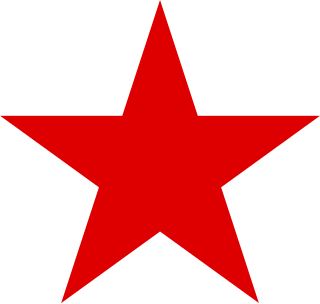
The Socialist Party of Indonesia was a political party in Indonesia from 1948 until 1960, when it was banned by President Sukarno.
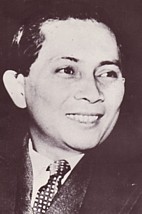
The position of Prime Minister of Indonesia existed from 1945 until 1966. During this period, the prime minister was in charge of the Cabinet of Indonesia, one of the three branches of government along with the People's Representative Council and the president. Following his 1959 decree, President Sukarno assumed the role and powers of prime minister until his resignation in 1966.

The Provisional Constitution of 1950 replaced the Federal Constitution of 1949 when Indonesia unilaterally withdrew from the union with the Netherlands agreed at the Round Table Conference and returned to being a unitary state. It came into force on 17 August 1950. It was abrogated on 5 July 1959 when President Sukarno issued a decree dissolving the Constitutional Assembly and restoring the 1945 Constitution of Indonesia.

The Liberal Democracy period in Indonesia, also known as the Era of Parliamentary Democracy, was a period in Indonesian political history, when the country was under a liberal democratic system. During this period, Indonesia held its first and only free and fair legislative election until 1999, but also saw continual political instability. The period began on 17 August 1950 following the dissolution of the federal United States of Indonesia, less than a year after its formation, and ended with the imposition of martial law and President Sukarno's decree, which resulted in the introduction of the Guided Democracy period on 5 July 1959.

The Cabinet of the Republic of Indonesia is part of the executive branch of the Indonesian government. It is composed of the most senior appointed officers of the executive branch of the government serving under the president. Members of the Cabinet serves at the president's pleasure, who can dismiss them at will for no cause.

The Central Indonesian National Committee, also known as the Central National Committee, was a body appointed to assist the president of the newly independent Indonesia. Originally purely advisory, it later gained assumed legislative functions. The Working Committee of the KNIP became part of the People's Representative Council when Indonesia became a unitary state in 1950.

The Presidential Cabinet was the first cabinet established by Indonesia following the 17 August 1945 Indonesian Declaration of Independence. It comprised 20 ministers and four officials. Its term of office ran from 2 September to 14 November 1945.

The Third Sjahrir Cabinet was the fourth Indonesian cabinet. It served from October 1946 to July 1947, when it fell due to disagreements related to the implementation of the Linggadjati Agreement and subsequent negotiations with the Dutch.
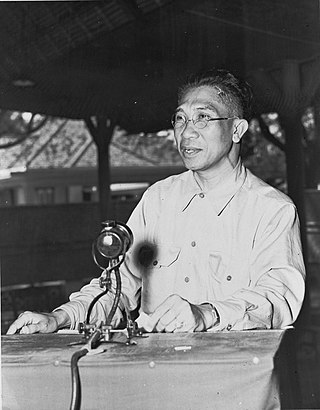
Tjokorda Gde Raka Soekawati, was the only President of the State of East Indonesia from 1946 to its disestablishment in 1950. He served from 1946 until the dissolution of the East Indonesian State in 1950. His title, Tjokorda Gde, signaled that Soekawati belonged to the highest ksatria. He had two wives, the first a Balinese, Gusti Agung Niang Putu, who gave him a son named Tjokorda Ngurah Wim Sukawati. In 1933, he married a French woman named Gilbert Vincent, who gave him two children.

Sjafruddin Prawiranegara's Emergency Cabinet was the government of the Emergency Government of the Republic of Indonesia (PDRI), effectively Indonesia's government in exile, established in Bukittinggi, West Sumatra following the second Dutch military aggression when the republican capital of Yogyakarta was seized and most of the cabinet allowed itself to be captured in the hope of attracting sympathy from the outside world.

The Second Hatta Cabinet was Indonesia's ninth cabinet. It was formed after the Indonesian leadership, which had been imprisoned by Dutch forces, returned to the capital, Yogyakarta. It served from 4 August to 20 December 1949.
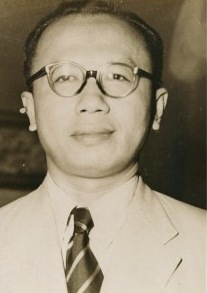
Djuanda Kartawidjaja, more commonly referred to mononymously as Djuanda, was an Indonesian politician and technocrat who held various positions during the presidency of Sukarno, most notably as prime minister of Indonesia and a cabinet minister in several cabinets.
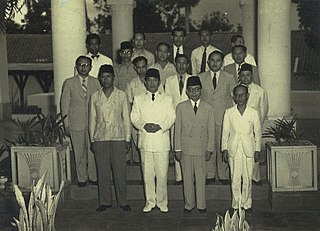
The Soekiman Cabinet, also known as the Sukiman-Suwirjo Cabinet, was an Indonesian cabinet that served from 27 April 1951 until it fell on 23 February 1952 following revelations that it had signed a mutual security agreement with the United States, and was dissolved on 3 April 1952.
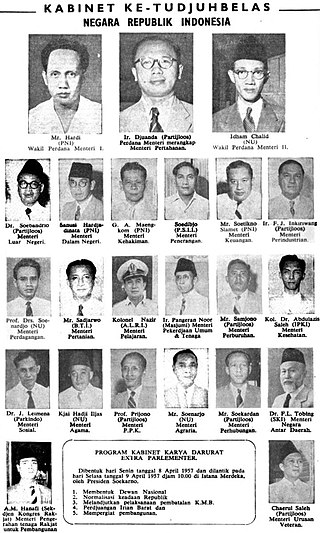
The Djuanda Cabinet, also known as the Working Cabinet, was an Indonesian cabinet that served from 9 April 1957 until 10 July 1959, when it was dissolved by a decree from President Sukarno.

The Federal Consultative Assembly, (BFO) was a committee established on 8 July 1948 to discuss the form of the planned federal United States of Indonesia. Its membership comprised the leaders of the various federal states established by the Dutch in the areas they occupied following their attack on the areas of Indonesia controlled by republican forces during the Indonesian National Revolution (1945–1949). It took part in negotiations with the Dutch in August and September 1948, and participated in the Dutch–Indonesian Round Table Conference at which the Dutch agreed to hand over sovereignty to the United States of Indonesia.
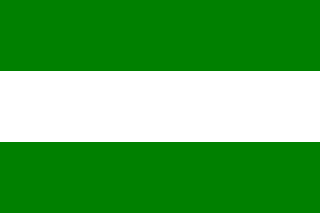
The State of Pasundan was a federal state (negara bagian) formed in the western part of the Indonesian island of Java by the Netherlands in 1948 following the Linggadjati Agreement. It was similar to the geographical area now encompassed by the current provinces of West Java, Banten and Jakarta.

The United States of Indonesia was a short-lived federal state to which the Netherlands formally transferred sovereignty of the Dutch East Indies on 27 December 1949 following the Dutch–Indonesian Round Table Conference. This transfer ended the four-year conflict between Indonesian nationalists and the Netherlands for control of Indonesia. It lasted less than a year, before being replaced by the unitary Republic of Indonesia.

The State of the Republic of Indonesia was a federated state (negara bagian) of the United States of Indonesia (RUSI) which was established on 27 December 1949. The territory of the state included parts of Java and most of Sumatra, and its capital was Yogyakarta. The acting president of the Republic was Assaat and the prime minister was first Susanto Tirtoprodjo until 16 January 1950, then Abdul Halim. On 17 August, the United States of Indonesia ceased to exist as the last of the component states dissolved themselves into a unitary Republic of Indonesia encompassing the entire territory of the former Dutch East Indies except for West Papua.
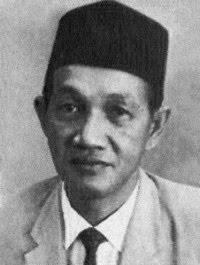
Idham Chalid was an Indonesian politician, religious leader, and minister, who served as Chairman of the People's Consultative Assembly and Chairman of the People's Representative Council from 1972 until 1977. He was also a prominent leader of the Nahdlatul Ulama (NU) and leader of the United Development Party (PPP), from 1956 until 1984.
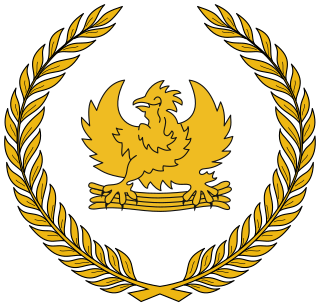
The Cabinet of the State of East Indonesia served as the central government apparatus of the State of East Indonesia, headed by a prime minister who were appointed by the head of state. During the three-year lifetime of the state between 24 December 1946 and 27 December 1949, there were eight cabinets in total, headed by six different prime ministers.





















